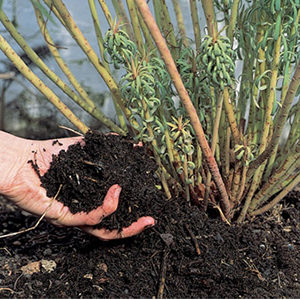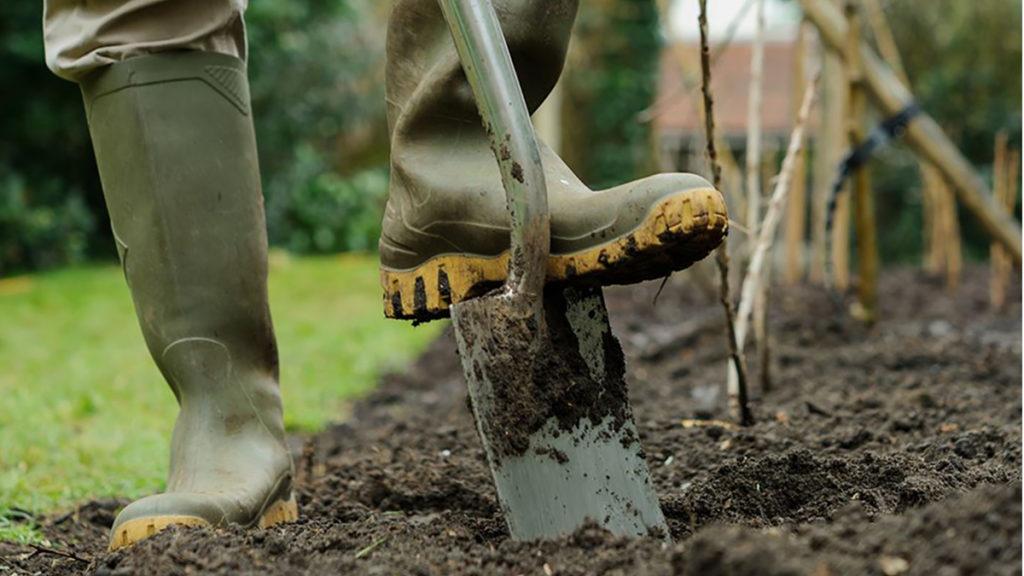Ask anyone who has a lush garden "what's your secret." They'll likely tell you that it's all about the soil. Soil is a living, dynamic ecosystem. Healthy soil is teeming with microscopic and larger organisms that perform many vital functions. This includes converting dead and decaying matter as well as minerals to plant nutrients. It’s the key to everything when growing healthy plants — successful rooting, vigorous growth, great harvests, weed, pest, and disease control.
If your soil is, well, let’s call it challenged, you can improve it. We asked John Keller who heads-up Production Planning and Research here at Monrovia. (And, who is a lifelong gardener himself). He schooled us a bit on the basics of soil. He also gave some tips on how to make poor soils come alive.
Here are the most common questions people have asked us about soil. Have others? Leave a comment below.
Our Secret Sauce
Each of the 4,000 plant varieties we grow is nurtured in a customized soil mix. With the large number of soil mixes we have (79). We can tailor the soil more precisely to a group of plants. We also add mycorrhizae, a “good fungus” that helps roots absorb moisture and nutrients from the soil. This gets your plants get off to a great start.
What is "Good Soil"?
(<—-Do not be freaked out by this!)
"Good soil" is a friable, fertile, well-drained soil that has the organic matter. It also has nutrients your particular plant needs to thrive.
If you were to test your soil, you would find that it contains some percentage of sand, silt and clay. (Try the simple mason jar method). Together, these components make-up the so-called “soil triangle.” With sand being the most coarse particles in the soil, clay being the finest particles, and silt being intermediate. Generally, loamy soils towards the middle-lower portion of the triangle are considered the best, comprised of 40% sand, 40% silt and 20% clay.
Soils are also classified according to their organic matter content. Organic matter is important because it provides nutrients to plant roots. It helps support a beneficial microbial environment in the soil and increases water holding capacity of soil. It also "glues together" smaller soil particles into larger aggregates that increase the aeration of the soil.
All that said, it's difficult to define a "good soil." This is because it depends to some extent on the plants being grown. A clay soil, or a soil with a high sand content is not necessarily a "bad" soil. But, may require a different approach than the "perfect" loam soil.
What are the different types of soil?
The three most common types of soil textures you’re like to encounter are:
Sandy: Dry and gritty to the touch. Since the particles have huge spaces between them, it can't hold onto water and lacks nutrients. Almost any plant can grow well in sandy soil as long as they get enough water and nutrients (think hydroponics). Plants such as gazania, lavender, cosmos, rugosa roses are fine with this type of soil texture.
Clay: Sticky and slippery, slow-draining clay soil makes life difficult for many plants. Many ferns, switchgrass, black-eyed Susan, daylilies and Japanese iris don’t seem to mind.
Loamy: Loamy soil are a rich, dark color that crumbles easily in your hand. They are nutrient-rich and allow water to drain easily. They also hold just the right amount of moisture for plants to thrive and allows air to seep through. Plant what you like!
While changing a soil's basic texture is very difficult, you can improve its structure by adding amendments. (Making clay more porous, sand more water retentive.)
Okay, so how do I improve my soil?
Few of us are blessed with perfect soil such as the beautiful, black soils of the Midwest. This have accumulated organic matter over the eons to where it has decomposed to stable humus. (The waste products and remains of soil-dwelling microorganisms and bacteria). The rest of us need to grab a shovel and start working on improving ours. Here are a few ways to get better soil structure:
- Prepping a planting bed with deep cultivation is not a lot of fun. However, breaking-up heavy, compacted soil layers will help aerate the soil. It will also provide a better environment for quickly setting and then growing healthy roots.
- New beds for landscape plants should be amended before any plants go into the ground. For long-term benefits, choose an amendment that breaks down slowly. For instance, shredded bark and peat moss with the addition of compost. This, while it breaks down in a matter of months, bolsters the initial nutrient supply available to soil microorganisms. If your soil is mostly clay or sand, spread 4 to 5 inches of amendment over it. If the soil is loamy or regularly amended each season, add just 2 to 3 inch layer of amendment. Spread onto soil surface and till into the top 4 – 6 inches of soil.
- Permanent or semipermanent plantings of trees, shrubs, or perennials benefit from soil amendment too. But, you need to do the job without damaging plant roots. Simply spread the amendment over the soil surface as a mulch. Earthworms, microorganisms, rain, and irrigation water will all carry it downward over time. Thus, gradually improving the soil's top layer. How much? Where soil is stubborn clay or sieve-like sand, add 4 to 6 inches of compost before each planting season. If soil is already nice and loamy still add compost–1 to 3 inches of fresh compost before each planting season. Note: yes, every planting season.
- Soil amendments such as lime, sulfur, and organic fertilizers can help create good fertility and pH level for plant growth. Don't assume your soil needs. Don't apply without first consulting a reputable garden center for the types of amendments that are recommended in their area. For example, lime application is generally not needed in the arid western states. Sulfur is generally not needed in the temperate Midwestern states.
Is there such a thing as "impossible" soil?
Yes, there is such a thing as “impossible soil” – it’s in my back yard! But seriously, almost any soil can be improved. Adding well-composted organic matter is probably one of the best ways to feed the soil. It also builds good soil fertility and structure over time.
All planted! How do I keep improving my soil?

It’s important to keep on caring for your soil after planting. Mulching and, where necessary, applying fertilizers around plants is an effective way to improve soil in an established garden.
Mulch keeps plant root zones cool in the summer, suppresses weeds, and gradually degrades. It adds organic matter to the soil. A light fertilization going into spring and again in the summer will help plants thrive.
In areas with cold weather, fertilizer late in the summer and into fall is usually avoided. This is because it can prolong vigorous growth into the fall, making the plant more susceptible to cold damage.
